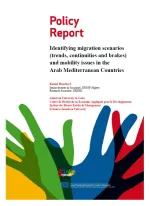Identifying migration scenarios (trends, continuities and brakes) and mobility issues in the Arab Mediterranean Countries

SAHWA Policy Report, nº. 7
Our paper forms part of the general problematic of the SAHWA Project, 2 which asks questions about the fate of the social group of young people in the Arab world and, more particularly, in the countries of the south and east of the Mediterranean basin (Algeria, Egypt, Lebanon, Morocco and Tunisia), since the socio-political earthquakes engendered by what is commonly called the “Arab Spring”. Our paper concentrates on the specific issue of the relations between young people in Arab societies and the issue of migration now that it has taken on troubling and dangerous proportions. Our paper does not include the case of Tunisia, due to the authors not having received the report on that country’s migration policy These days, immigration along the south-north axis has grown to alarming proportions. To be sure, the phenomenon is a historical fact. But the novelty is that the new migratory configurations involve many more young people and irregular and illegal forms are wellestablished. In this context, the Arab Mediterranean countries are notable for being “exporter” countries of migrants and invite, as a result, questioning of the dysfunctionalities eroding their inefficient social systems. Further still, these same countries are increasingly becoming incorporated into the largest international migratory movements, making them countries of both destination and of transit for migrants and asylum seekers.